The global AR coating liquid market is projected to reach USD 499.1 million by 2035, recording an absolute increase of USD 165.1 million over the forecast period. The market is valued at USD 334 million in 2025 and is set to rise at a CAGR of 4.1% during the assessment period. The market size is expected to grow by nearly 1.5 times during the same period, supported by increasing demand for optical clarity solutions worldwide, driving demand for efficient anti-reflective coating systems, and increasing investments in renewable energy and consumer electronics manufacturing projects globally. High raw material costs and complex formulation requirements for advanced coating systems may pose challenges to market expansion.
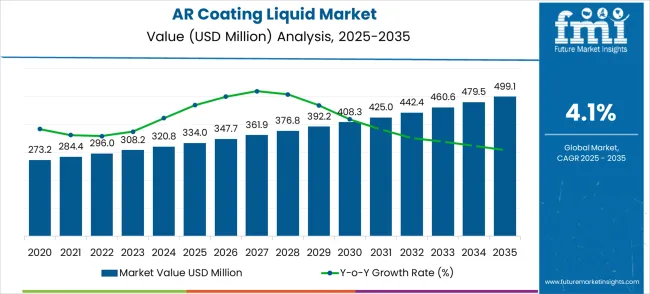
Between 2025 and 2030, the AR coating liquid market is estimated to expand from USD 334 million to USD 408.3 million, resulting in a value increase of USD 74.3 million, which represents 45.0% of the total forecast growth for the decade. This phase of development will be shaped by rising demand for renewable energy and optical applications, product innovation in coating technologies and precision manufacturing systems, as well as expanding integration with smart manufacturing and automation initiatives. Companies are establishing competitive positions through investment in advanced coating formulations, sustainable production solutions, and strategic market expansion across energy, optical, and consumer electronics applications.
From 2030 to 2035, the market is forecast to grow from USD 408.3 million to USD 499.1 million, adding another USD 90.8 million, which constitutes 55.0% of the ten-year expansion. This period is expected to be characterized by the expansion of specialized coating systems, including advanced multi-layer formulations and integrated application solutions tailored for specific industry requirements, strategic collaborations between chemical manufacturers and end-user industries, and an enhanced focus on production efficiency and environmental friendliness. The growing emphasis on optical performance optimization and sustainable manufacturing processes will drive demand for advanced, high-performance AR coating liquid solutions across diverse industrial applications.
| Metric | Value |
|---|---|
| Market Value (2025) | USD 334 million |
| Market Forecast Value (2035) | USD 499.1 million |
| Forecast CAGR (2025-2035) | 4.1% |
The AR coating liquid market grows by enabling manufacturers to achieve superior optical clarity and light transmission efficiency in various applications, ranging from solar panels to consumer electronics. Industrial manufacturers face mounting pressure to improve product performance and energy efficiency, with anti-reflective coating solutions typically providing 3-8% improvement in light transmission compared to uncoated surfaces, making AR coating liquids essential for competitive manufacturing operations. The renewable energy industry's need for maximum energy conversion efficiency creates demand for advanced coating solutions that can minimize reflection losses, enhance durability, and ensure consistent performance across diverse environmental conditions. Government initiatives promoting renewable energy adoption and energy efficiency standards drive adoption in photovoltaic, optical instruments, and consumer electronics applications, where optical performance has a direct impact on device efficiency and user experience. Raw material price volatility and the complexity of achieving consistent coating quality across different substrates may limit adoption rates among cost-sensitive manufacturers and developing regions with limited technical expertise.
The market is segmented by coating layer type, application, and region. By coating layer type, the market is divided into single-layer coating liquid and dual-layer coating liquid. Based on the application, the market is categorized into energy photovoltaic, optical instruments, consumer electronics, architectural decoration, and other applications. Regionally, the market is divided into Asia Pacific, Europe, North America, and other key regions.
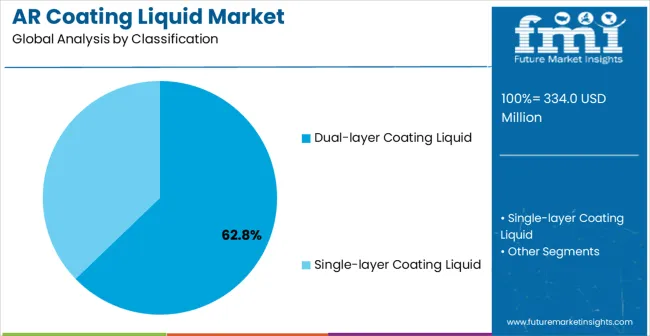
The dual-layer coating liquid segment represents the dominant force in the AR coating liquid market, capturing approximately 62.8% of total market share in 2025. This advanced technology category encompasses formulations featuring sophisticated optical interference designs, including precisely controlled refractive index layers and optimized thickness combinations that enable superior anti-reflective performance and enhanced durability characteristics. The dual-layer segment's market leadership stems from its exceptional optical performance capabilities, with coatings capable of achieving less than 1% reflection across visible wavelengths while maintaining consistent performance and environmental resistance across diverse operating conditions.
The single-layer coating liquid segment maintains a substantial 37.2% market share, serving manufacturers who require cost-effective anti-reflective solutions for standard applications. These formulations offer reliable performance for general-purpose optical applications while providing sufficient reflection reduction to meet basic performance requirements in consumer electronics and architectural applications.
Key technological advantages driving the dual-layer segment include:
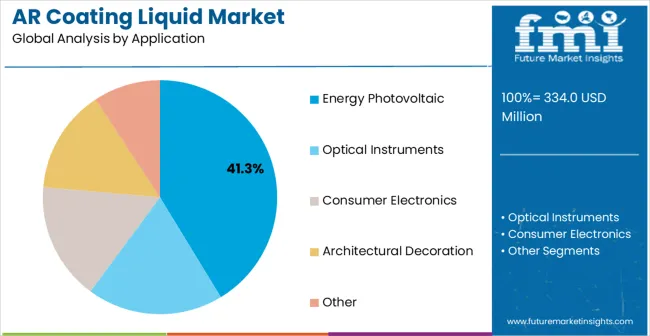
Energy photovoltaic applications dominate the AR coating liquid market with approximately 41.3% market share in 2025, reflecting the critical role of anti-reflective coatings in maximizing solar energy conversion efficiency and supporting global renewable energy development initiatives. The photovoltaic segment's market leadership is reinforced by accelerating solar installations, government renewable energy policies, and rising demand for energy efficiency optimization that directly correlates with coating performance quality.
The optical instruments segment represents the second-largest application category, capturing 24.7% market share through specialized requirements for precision optical systems, scientific instruments, and industrial optical equipment. This segment benefits from growing demand for high-performance optical coatings that meet stringent clarity, durability, and precision requirements in demanding professional applications.
The consumer electronics segment accounts for 18.9% market share, serving display manufacturers and mobile device producers requiring anti-glare and clarity enhancement solutions. The architectural decoration segment captures 10.4% market share through building glass applications, while other applications represent 4.7% of the market.
Key market dynamics supporting application growth include:
The market is driven by three concrete demand factors tied to performance optimization outcomes. First, renewable energy sector growth and solar installation expansion create increasing demand for high-performance anti-reflective solutions, with global solar capacity projected to grow by 15-20% annually in major markets worldwide, requiring specialized coating solutions for maximum energy conversion efficiency. Second, consumer electronics advancement and display technology evolution drive the adoption of superior optical coatings, with manufacturers seeking 5-8% improvement in light transmission and user experience enhancement. Third, technological advancements in materials science and nanotechnology enable more effective and durable coating solutions that reduce maintenance requirements while improving long-term performance and cost-effectiveness.
Market restraints include raw material price volatility that can impact production costs and profitability margins, particularly during periods of supply chain disruption or commodity price fluctuations affecting key chemical components. Technical complexity in formulation development poses another significant challenge, as achieving consistent coating quality across different substrates and environmental conditions requires specialized expertise and quality control systems, potentially causing production delays and increased manufacturing costs. Environmental regulations and requirements create additional complexity for manufacturers, demanding ongoing investment in eco-friendly formulations and compliance with varying regional ecological standards.
Key trends indicate accelerated adoption in Asia-Pacific markets, particularly China and India, where rapid renewable energy deployment and manufacturing expansion drive comprehensive AR coating system development. Technology advancement trends toward nanotechnology integration with enhanced durability, self-cleaning properties, and multi-functional coating capabilities enable next-generation product development that addresses multiple performance requirements simultaneously. The market thesis could face disruption if alternative optical enhancement technologies or significant changes in renewable energy system designs minimize reliance on traditional anti-reflective coating solutions.
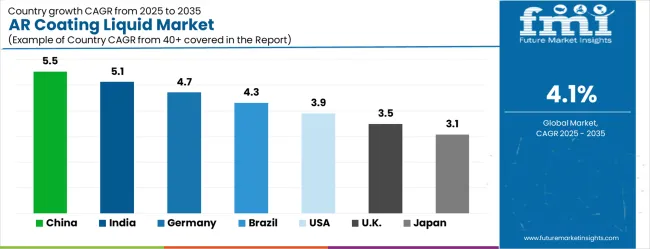
| Country | CAGR (2025-2035) |
|---|---|
| China | 5.5% |
| India | 5.1% |
| Germany | 4.7% |
| Brazil | 4.3% |
| USA | 3.9% |
| UK | 3.5% |
| Japan | 3.1% |
The AR coating liquid market is gaining momentum worldwide, with China taking the lead thanks to massive renewable energy expansion and government-backed manufacturing modernization programs. Close behind, India benefits from growing solar installations and consumer electronics manufacturing initiatives, positioning itself as a strategic growth hub in the Asia-Pacific region. Germany shows steady advancement, where integration of advanced coating technologies strengthens its role in the European renewable energy and optical equipment supply chains. Brazil is focusing on renewable energy development and industrial modernization, signaling an ambition to capitalize on growing opportunities in South American energy markets. Meanwhile, the USA stands out for its advanced technology development in existing coating applications, and the UK and Japan continue to record consistent progress in optical technology advancement. Together, China and India anchor the global expansion story, while the rest build stability and diversity into the market's growth path.
The report covers an in-depth analysis of 40+ countries, top-performing countries are highlighted below.
China demonstrates the strongest growth potential in the AR Coating Liquid Market with a CAGR of 5.5% through 2035. The country's leadership position stems from massive renewable energy projects, government-backed manufacturing modernization programs, and aggressive solar installation targets, driving the adoption of high-performance anti-reflective coating systems. Growth is concentrated in major manufacturing regions, including Guangdong, Jiangsu, Zhejiang, and Shandong, where solar panel manufacturers and electronics companies are implementing advanced coating solutions for enhanced product performance and international competitiveness. Distribution channels through established chemical suppliers and direct manufacturer relationships expand deployment across photovoltaic manufacturing facilities and consumer electronics production lines. The country's renewable energy leadership strategy provides policy support for advanced materials development, including high-performance coating system adoption.
Key market factors:
In Mumbai, Bangalore, Chennai, and Hyderabad, the adoption of AR coating liquid systems is accelerating across solar manufacturing facilities and electronics production centers, driven by renewable energy targets and government Make in India initiatives. The market demonstrates strong growth momentum with a CAGR of 5.1% through 2035, linked to comprehensive solar capacity expansion and increasing focus on manufacturing competitiveness solutions. Indian manufacturers are implementing advanced coating systems and quality control platforms to enhance product performance while meeting growing demand for solar panels and consumer electronics in domestic and export markets. The country's National Solar Mission creates sustained demand for high-performance coating solutions, while increasing emphasis on local manufacturing drives adoption of advanced materials and production technologies.
Germany's advanced chemical industry demonstrates sophisticated implementation of AR coating liquid systems, with documented case studies showing 6% efficiency improvements in solar applications through optimized anti-reflective solutions. The country's manufacturing infrastructure in major industrial centers, including North Rhine-Westphalia, Bavaria, Baden-Württemberg, and Lower Saxony, showcases integration of advanced coating technologies with existing production systems, leveraging expertise in chemical engineering and precision manufacturing.
German manufacturers emphasize quality standards and environmental compliance, creating demand for high-performance coating solutions that support initiatives and regulatory requirements. The market maintains steady growth through focus on technology innovation and export competitiveness, with a CAGR of 4.7% through 2035.
Key development areas:
Brazil's market expansion is driven by diverse renewable energy demand, including solar installations in Minas Gerais and São Paulo, manufacturing development in Santa Catarina and Rio Grande do Sul, and comprehensive industrial modernization across multiple regions. The country demonstrates promising growth potential with a CAGR of 4.3% through 2035, supported by federal renewable energy programs and regional industrial development initiatives. Brazilian manufacturers face implementation challenges related to import dependency and technical expertise availability, requiring technology transfer approaches and international partnership support. Growing renewable energy targets and manufacturing competitiveness requirements create compelling business cases for AR coating system adoption, particularly in solar manufacturing regions where performance optimization has a direct impact on export competitiveness.
Market characteristics:
The USA market leads in advanced coating innovation based on integration with next-generation solar technologies and sophisticated optical applications for enhanced performance characteristics. The country shows solid potential with a CAGR of 3.9% through 2035, driven by renewable energy expansion programs and advanced manufacturing initiatives across major industrial regions, including California, Texas, North Carolina, and Arizona. American manufacturers are adopting advanced coating systems for performance optimization and regulatory compliance, particularly in states with renewable energy mandates and advanced manufacturing facilities requiring superior product differentiation. Technology deployment channels through established chemical distributors and direct manufacturer relationships expand coverage across solar manufacturing and optical equipment production facilities.
Leading market segments:
In England, Scotland, Wales, and Northern Ireland, manufacturing facilities are implementing AR coating liquid solutions to enhance renewable energy system performance and improve manufacturing competitiveness, with documented case studies showing 4% improvement in solar panel efficiency through optimized coating applications. The market shows moderate growth potential with a CAGR of 3.5% through 2035, linked to renewable energy development programs, offshore wind integration projects, and emerging clean technology manufacturing initiatives. British manufacturers are adopting advanced coating and quality systems to enhance product performance while maintaining environmental standards demanded by UK regulations and international export markets. The country's established chemical industry creates sustained demand for technology upgrade solutions that integrate with existing manufacturing systems.
Market development factors:
Japan's AR coating liquid market demonstrates sophisticated implementation focused on precision engineering and quality excellence optimization, with documented integration of advanced coating systems achieving 5% improvement in optical performance across electronics and solar applications. The country maintains steady growth momentum with a CAGR of 3.1% through 2035, driven by manufacturers' emphasis on quality standards and continuous improvement methodologies that align with lean manufacturing principles applied to materials processing operations. Major industrial regions, including Kanto, Kansai, Chubu, and Kyushu, showcase advanced deployment of precision coating platforms where systems integrate seamlessly with existing quality control systems and comprehensive manufacturing management programs.
Key market characteristics:
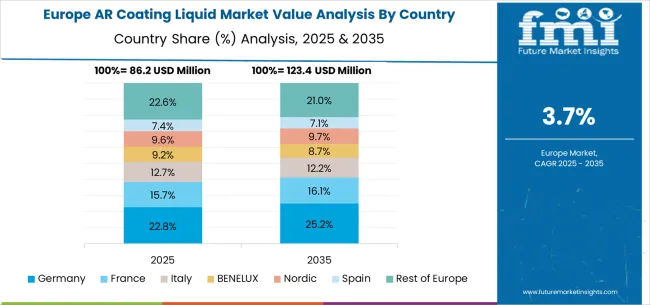
The AR coating liquid market in Europe is projected to grow from USD 83.5 million in 2025 to USD 124.8 million by 2035, registering a CAGR of 4.1% over the forecast period. Germany is expected to maintain its leadership position with a 34.2% market share in 2025, declining slightly to 33.8% by 2035, supported by its extensive chemical manufacturing infrastructure and major industrial centers, including Munich, Stuttgart, and Frankfurt production facilities.
The United Kingdom follows with an 18.6% share in 2025, projected to reach 19.1% by 2035, driven by comprehensive renewable energy development programs and advanced manufacturing initiatives implementing coating technologies. France holds a 15.9% share in 2025, expected to maintain 15.4% by 2035 through ongoing industrial facility upgrades and chemical technology development. Italy commands a 14.8% share, while Spain accounts for 10.2% in 2025. The Rest of Europe region is anticipated to gain momentum, expanding its collective share from 6.3% to 7.4% by 2035, attributed to increasing AR coating adoption in Nordic countries and emerging Eastern European manufacturing facilities implementing advanced materials programs.
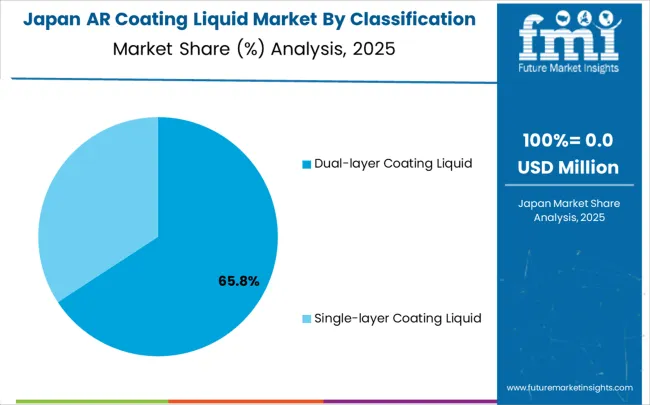
The Japanese AR Coating Liquid Market demonstrates a mature and quality-focused landscape, characterized by sophisticated integration of dual-layer coating liquid systems with existing precision manufacturing infrastructure across electronics production facilities, optical instrument manufacturers, and specialized coating application centers. Japan's emphasis on manufacturing excellence and quality standards drives demand for high-reliability coating solutions that support kaizen continuous improvement initiatives and statistical process control requirements in precision manufacturing operations.
The market benefits from strong partnerships between international chemical providers like Covestro, 3M, and domestic specialty chemical leaders, including Asahi Kasei, Shin-Etsu Chemical, and JSR Corporation, creating comprehensive service ecosystems that prioritize coating consistency and application precision programs. Manufacturing centers in Tokyo, Osaka, Nagoya, and other major industrial areas showcase advanced quality control implementations where coating systems achieve 97% consistency through integrated monitoring programs.
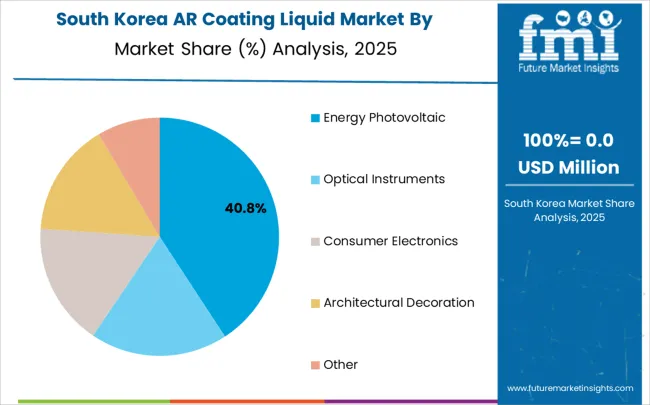
The South Korean AR Coating Liquid Market is characterized by strong international technology provider presence, with companies like Covestro, DSM, and 3M maintaining significant positions through comprehensive system integration and technical services capabilities for electronics manufacturing and renewable energy applications. The market is demonstrating growing emphasis on advanced materials development and precision application capabilities, as Korean manufacturers increasingly demand customized solutions that integrate with domestic advanced manufacturing infrastructure and sophisticated quality control systems deployed across Samsung, LG, and other major industrial complexes.
Local chemical companies and regional specialty manufacturers are gaining market share through strategic partnerships with global providers, offering specialized services including Korean market customization and technical support programs for precision applications. The competitive landscape shows increasing collaboration between multinational chemical companies and Korean technology specialists, creating hybrid service models that combine international materials expertise with local manufacturing knowledge and quality management systems.
The AR coating liquid market features approximately 15-20 meaningful players with moderate concentration, where the top three companies control roughly 45-52% of global market share through established technology platforms and extensive chemical industry relationships. Competition centers on optical performance quality, formulation reliability, and application expertise rather than price competition alone.
Market leaders include Covestro, DSM, and 3M, which maintain competitive advantages through comprehensive chemical solution portfolios, global manufacturing networks, and deep expertise in the specialty chemicals and optical materials sectors, creating high switching costs for customers. These companies leverage research and development capabilities and ongoing technical support relationships to defend market positions while expanding into adjacent optical and renewable energy applications.
Challengers encompass Yongan Optic and Junhe Technology, which compete through specialized coating solutions and strong regional presence in key manufacturing markets. Technology specialists, including Junsheng Material, Sysmyk, and Winlight, focus on specific coating formulations or vertical applications, offering differentiated capabilities in application techniques, customization services, and specialized performance characteristics.
Regional players and emerging chemical providers create competitive pressure through cost-effective solutions and rapid customization capabilities, particularly in high-growth markets including China and India, where local presence provides advantages in customer service and regulatory compliance. Market dynamics favor companies that combine advanced chemical technologies with comprehensive technical support offerings that address the complete coating lifecycle from formulation development through ongoing application optimization.
AR coating liquids represent specialized chemical formulations that enable manufacturers to achieve 3-8% improvement in light transmission efficiency compared to uncoated surfaces, delivering superior optical clarity and anti-reflective performance with less than 1% reflection across visible wavelengths in demanding applications. With the market projected to grow from USD 334 million in 2025 to USD 499.1 million by 2035 at a 4.1% CAGR, these coating systems offer compelling advantages - enhanced energy conversion efficiency, customizable optical properties, and environmental durability - making them essential for energy photovoltaic applications (41.3% market share), optical instruments (24.7% share), and consumer electronics seeking alternatives to uncoated substrates that compromise performance through excessive reflection losses. Scaling market adoption and technological advancement requires coordinated action across renewable energy policy, optical standards development, specialty chemical manufacturers, application industries, and materials science investment capital.
How Governments Could Spur Local Production and Adoption?
How Industry Bodies Could Support Market Development?
How OEMs and Technology Players Could Strengthen the Ecosystem?
How Suppliers Could Navigate the Shift?
How Investors and Financial Enablers Could Unlock Value?
| Item | Value |
|---|---|
| Quantitative Units | USD 334 million |
| Coating Layer Type | Single-layer Coating Liquid, Dual-layer Coating Liquid |
| Application | Energy Photovoltaic, Optical Instruments, Consumer Electronics, Architectural Decoration, Other |
| Regions Covered | Asia Pacific, Europe, North America, Latin America, Middle East & Africa |
| Country Covered | China, India, Germany, Brazil, the USA, the UK, Japan, and 40+ countries |
| Key Companies Profiled | Covestro, DSM, 3M, Yongan Optic, Junhe Technology, Junsheng Material, Sysmyk, Winlight |
| Additional Attributes | Dollar sales by coating layer type and application categories, regional adoption trends across Asia Pacific, Europe, and North America, competitive landscape with chemical providers and technology integrators, manufacturing facility requirements and specifications, integration with renewable energy initiatives and optical systems, innovations in coating technology and application systems, and development of specialized formulations with performance and durability capabilities. |
The global AR coating liquid market is estimated to be valued at USD 334.0 million in 2025.
The market size for the AR coating liquid market is projected to reach USD 499.1 million by 2035.
The AR coating liquid market is expected to grow at a 4.1% CAGR between 2025 and 2035.
The key product types in AR coating liquid market are dual-layer coating liquid and single-layer coating liquid.
In terms of application, energy photovoltaic segment to command 41.3% share in the AR coating liquid market in 2025.






Our Research Products

The "Full Research Suite" delivers actionable market intel, deep dives on markets or technologies, so clients act faster, cut risk, and unlock growth.

The Leaderboard benchmarks and ranks top vendors, classifying them as Established Leaders, Leading Challengers, or Disruptors & Challengers.

Locates where complements amplify value and substitutes erode it, forecasting net impact by horizon

We deliver granular, decision-grade intel: market sizing, 5-year forecasts, pricing, adoption, usage, revenue, and operational KPIs—plus competitor tracking, regulation, and value chains—across 60 countries broadly.

Spot the shifts before they hit your P&L. We track inflection points, adoption curves, pricing moves, and ecosystem plays to show where demand is heading, why it is changing, and what to do next across high-growth markets and disruptive tech

Real-time reads of user behavior. We track shifting priorities, perceptions of today’s and next-gen services, and provider experience, then pace how fast tech moves from trial to adoption, blending buyer, consumer, and channel inputs with social signals (#WhySwitch, #UX).

Partner with our analyst team to build a custom report designed around your business priorities. From analysing market trends to assessing competitors or crafting bespoke datasets, we tailor insights to your needs.
Supplier Intelligence
Discovery & Profiling
Capacity & Footprint
Performance & Risk
Compliance & Governance
Commercial Readiness
Who Supplies Whom
Scorecards & Shortlists
Playbooks & Docs
Category Intelligence
Definition & Scope
Demand & Use Cases
Cost Drivers
Market Structure
Supply Chain Map
Trade & Policy
Operating Norms
Deliverables
Buyer Intelligence
Account Basics
Spend & Scope
Procurement Model
Vendor Requirements
Terms & Policies
Entry Strategy
Pain Points & Triggers
Outputs
Pricing Analysis
Benchmarks
Trends
Should-Cost
Indexation
Landed Cost
Commercial Terms
Deliverables
Brand Analysis
Positioning & Value Prop
Share & Presence
Customer Evidence
Go-to-Market
Digital & Reputation
Compliance & Trust
KPIs & Gaps
Outputs
Full Research Suite comprises of:
Market outlook & trends analysis
Interviews & case studies
Strategic recommendations
Vendor profiles & capabilities analysis
5-year forecasts
8 regions and 60+ country-level data splits
Market segment data splits
12 months of continuous data updates
DELIVERED AS:
PDF EXCEL ONLINE
Artificial Ear Simulator Market Size and Share Forecast Outlook 2025 to 2035
Area Gripper Market Size and Share Forecast Outlook 2025 to 2035
Arch Top Casement Window Market Size and Share Forecast Outlook 2025 to 2035
Arc Flash Risk Assessment Market Size and Share Forecast Outlook 2025 to 2035
Arch Top Door Market Size and Share Forecast Outlook 2025 to 2035
Aramid Flame Retardant Webbing Market Size and Share Forecast Outlook 2025 to 2035
Aromatherapy Market Size and Share Forecast Outlook 2025 to 2035
Arthroscopy Devices Market Size and Share Forecast Outlook 2025 to 2035
Aramid Honeycomb Core Material Market Size and Share Forecast Outlook 2025 to 2035
Artificial Intelligence (chipset) Market Forecast and Outlook 2025 to 2035
AR and VR in Training Market Size and Share Forecast Outlook 2025 to 2035
AR Coated Film Glass Market Size and Share Forecast Outlook 2025 to 2035
Artificial Insemination Market Size and Share Forecast Outlook 2025 to 2035
Artificial Intelligence in Construction Market Size and Share Forecast Outlook 2025 to 2035
Artificial Tears Market Size and Share Forecast Outlook 2025 to 2035
Artificial Intelligence in Telecommunication Market Size and Share Forecast Outlook 2025 to 2035
Artificial Urinary Sphincter Market Size and Share Forecast Outlook 2025 to 2035
Art and Office Marker Pen Market Size and Share Forecast Outlook 2025 to 2035
Architectural Membranes Market Size and Share Forecast Outlook 2025 to 2035
Areca Nut Market Size and Share Forecast Outlook 2025 to 2035

Thank you!
You will receive an email from our Business Development Manager. Please be sure to check your SPAM/JUNK folder too.
Chat With
MaRIA